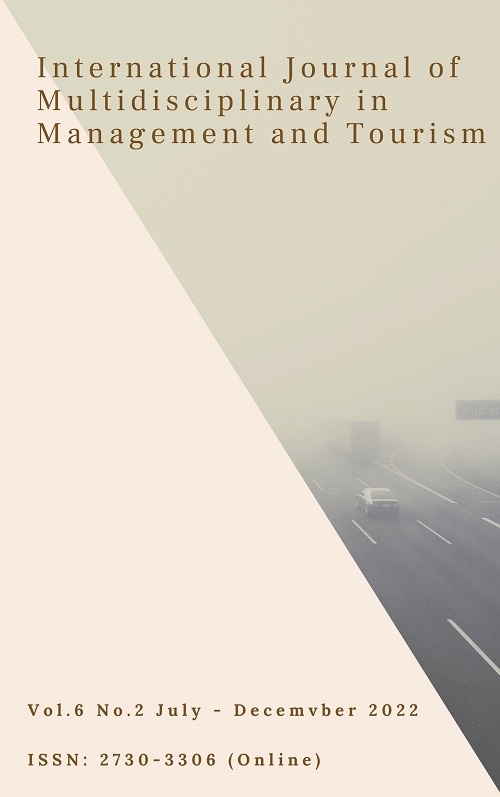Exploring King Vajiravudh’s Official Nationalism through Art Discourse
Main Article Content
Abstract
Art, in all creative forms and productions, has played a leading role in shaping and constructing political ideologies, values and actions. Being influenced by its spatial-temporal dimensions, art often reflects social and political conditions by taking account of intentions, motivations, and reasons for human action. The ruling bodies and state leaders often arouse nationalistic emotions of their subjects and instill the populace’s sentiment to maintain their status and position in society. This article explores the relationship of art and politics by addressing a distinctive form of official nationalism under King Vajiravudh, who sought to retain his political sovereignty by imposing the political ideology on all his subjects through art discourse. The development of nationalism in the Thai context is relatively unique in many ways that further raised questions – What is the main concept of official nationalism under King Vajiravudh? In what way did he use art to promote nationalistic sentiments? This study aims to provide a textual and historical analysis of art as political discourse of nationalism under King Vajiravudh. The main concept of his political ideology is to instill a new degree of commitment, loyalty and sacrifice to the nationalistic trinity of ‘Nation, Religion, and Monarchy’. The king valued the concept of civilised pedigree and used heritage to stimulate nationalistic sentiments through the revival of traditional art and architecture as a part of heritage conservation. The main theme for his performing art was to strengthen and glorify the institution of absolute monarchy and to propagate concept of national unity and patriotism with a great pride in Siamese cultural heritage.
Article Details

This work is licensed under a Creative Commons Attribution-NonCommercial-NoDerivatives 4.0 International License.
References
Anderson, B. (1991). Imagined communities: Reflections on the origin and spread of nationalism (revised edition). Verso books.
‘Asvabahu’ [King Vajiravudh]. (1914). Siamese Art, undated transcript in the National Archives. Bangkok.
Barmé, S. (1993). Luang Wichit Wathakan and the creation of a Thai identity. Institute of Southeast Asian Studies.
Coaldrake, W. H. (2002). Architecture and authority in Japan. Routledge.
Edelman, M. (1995). From Art to Politics: How Artistic Creations Shape Political Perceptions. University of Chicago Press.
El-Torky, A. A. (2018). Political symbolism in Mohammad Ali’s Mosque: Embodying political ideology in architecture. Alexandria Engineering Journal, 57(4), 3873-3880.
Glancey, J. (2003). The story of architecture. Edicoes Loyola.
Greene, S. L. W. (1999). Absolute dreams: Thai government under Rama VI, 1910-1925. White Lotus Press.
Ishii, Y. (1986). Sangha, state, and society: Thai Buddhism in history. University of Hawaii Press.
Ismail, A. S., & Zhaharin, E. N. (2017). Built form properties as sign and symbols of patron political ideology. Jurnal Kejuruteraan, 29(2), 87-96.
Kasetsiri, C. (2018). The construction of national heroes and/or heroines. In Southeast Asia over three generations (pp. 13-26). Cornell University Press.
King, R. J., & Amnuay-ngerntra, S. (2017). Heritage and interpretation: A tale of three palaces. In Heritage and identity in contemporary Thailand: Memory, place and power (pp. 48-67). National University of Singapore Press.
Khrouthongkhieo, N. (2020). The royal intention to produce works of art in King Vajiravudh reign. Humanities, Arts and Social Sciences Studies, 20(1), 90-118.
Kratoska, P. & Batson, B. (1999). Nationalism and modernist reform, In The Cambridge History of Southeast Asia: from early time to c. 1800 (Vol.1), 249-324, Cambridge University Press.
Mead, K. K. (2004). The rise and decline of Thai absolutism. Routledge.
Mina, P. (2015). The procedure of nationalism in King Rama VI’s play: A case study of Hua Jai Nak Rob. Retrieved September 15, 2022, from http://papers.iafor.org/wp-content/uploads/papers/libeuro2015/LibEuro2015_10366.pdf
Murashima, E. (1988). The origin of modern official state ideology in Thailand. Journal of Southeast Asian Studies, 19(1), 80 – 96.
Negash, G. (2004). Art invoked: A mode of understanding and shaping the political. International Political Science Review, 25(2), 185-201.
Noobanjong, K. (2003). Power, identity, and the rise of modern architecture: From Siam to Thailand. Universal-Publishers.
Norwich, J. J. (2000). Great architecture of the World. Mitchell Beazley Publisher Limited.
Poshyananda, A. (1992) Modern art in Thailand: Nineteenth and twentieth centuries. Oxford University Press.
Prakitnonthakarn, C. (2003). From old Siam to new Thai: Social and political meanings in architecture during 1892-1957 A.D.[Master’s thesis, Chulalongkorn University].
Pramoj, K. (1985). Pa Ta Ka Ta Num Silapakram Sa Mai Mai [Preamble Speech: Modern Art] in Bun Thuk Karn Sam Ma Nar Sil La Pa Kram Lang Por Sor 2475 [Seminar in Art after 1932]. Thai Kadi Research Institute, Thammasat University.
Rutnin, M. M. (1982). The politics of Thai classical dance-drama during the reign of King Rama VI. The Journal of Political Science, 8(2), 127-155.
Rutnin, M. M. (1996). Dance, drama, and theatre in Thailand: The process of development and modernization. University of Washington Press.
Sattayanurak, S. (2002). Intellectuals and the establishment of identities in the Thai absolute monarchy state, Journal of the Siam Society, 90(1), 101 – 124.
Sattayanurak, S. (2019). Thai identity and nationalism. In Routledge Handbook of Contemporary Thailand (pp. 241-252). Routledge.
Seton-Watson, H. (1977). Nations and states. Westwood Press.
Smith, A. (1971). Theories of nationalism. Harper and Row.
Suksri, N. & Freeman, M. (1996). Palaces of Bangkok: Royal residences of the Chakri dynasty. Asia Books.
Umavijani, M. (1981). King Vajiravudh and Phra Ruang. Siriporn Press.
Vajiravudh, King. (1955). Khwamhen Chat Doi Thae Ching [On Becoming a Genuine Nation], Pramuan Bot Phraachaniphon Phrabat
Somdet Phra Mongkut Klao Chao Yu Hua Phak Pakinaka [A collection of the writings of Rama VI, miscellaneous selections], 88-99. Bangkok.
Vella, W. (1974). Siamese nationalism in the plays of Rama VI, in Davis, A.R. (eds) Search for identity: Modern literature and the creative arts in Asia. Augus and Robertson.
Vella, W. (1978). Chaiyo! King Vajiravudh and the development of Thai nationalism, University of Hawaii Press.
Wongsurawat, W. (2021). National emotions and heroism in King Vajiravudh’s anti-Chinese propaganda writing. Diogenes, 0392192120970390.
Wyatt, D. (1994). Studies in Thai history. Silkworm Books.

